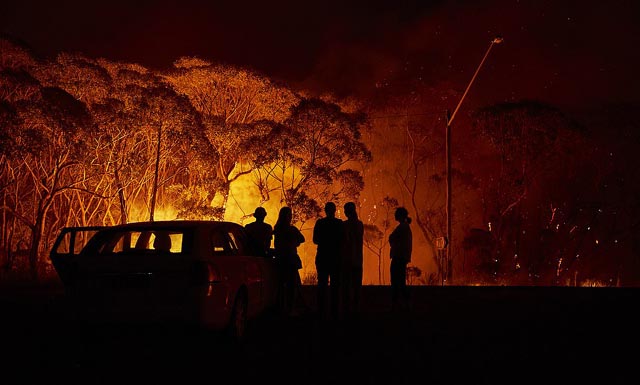
SYDNEY, Nov 1, 2023 (BSS/AFP) - Helicopters buzzed over bushfire-scarred swathes of eastern Australia on Wednesday, assessing the damage left by "shocking" blazes that raged overnight.
Water bombing aircraft swooped on fires smouldering in Queensland and New South Wales (NSW), while fire crews raced to dig containment lines as conditions eased on Wednesday morning.
Firefighters toiled through the night to repel bushfires on the border between the two states, while more than 50 houses have now been razed by a separate blaze on Queensland's Western Downs -- one of Australia's most vital food bowls.
"It was a really shocking day for firefighters and residents on both sides of the border," NSW fire chief Rob Rogers told Sky News.
Aerial fire service footage showed cars fleeing as a fire front swept towards Wallangarra on Tuesday evening, a rural town of about 500 people that is about three hours' drive south from Queensland's capital Brisbane.
A small number of homes had been destroyed but fire crews were able to prevent more significant destruction, officials said.
About 30 firefighters were flown from Sydney on Tuesday afternoon to reinforce crews protecting the northern NSW town of Tenterfield, which was surrounded by a ring of seven "dangerous" bushfires.
"These crews will support local firefighters to establish containment lines, reduce threat to properties and plan for coming days," the NSW Rural Fire Service said on Wednesday.
The service said it was using helicopters to search for damaged properties in the hard-to-reach hinterland, while heavy machinery dug containment lines during the reprieve.
Senior Queensland firefighter Mike Wassing said hot and dry winds were starting to die down, allowing some towns to focus on "relief and recovery".
But Wassing told national broadcaster ABC that some bushfires were "still very volatile and somewhat unstable".
Rain forecast over the weekend is expected to help douse some of the fires.
Australia is facing its most intense bushfire season since 2019-2020, when a series of out-of-control infernos raged across the eastern seaboard -- razing swathes of forest, killing millions of animals, and blanketing cities in noxious smoke.
In September, the national weather bureau confirmed that an El Nino weather pattern was under way, bringing soaring temperatures that risked a severe wildfire season and drought.